UK 2019 Parliamentary Election
Scotland in 2019 UK election
The outcome in Scotland was a romp for the Scottish Nationals, while down in the Southwest it was the Conservatives who were dominant If a Regional Seats system of election was used while not increasing the total size of Parliament, then the number of electoral districts would needs be reduced by the number of regions created.
Scotland currently has 59 Members of Parliament, and were it to be divided into ten regions, each having a Regional MP, then the electoral districts would be reduced to 49. That means the average increase for each would be about 20% in population.
Possible Regions:
Here is what that those regions might look like. [Although, of course, in a redistribution, the electoral districts may be rather different.]
- Islands & Highlands – ..Orkney & Shetland; ..Western Isles; ..Caithness, Sutherland…; ..Ross, Skye, Lochaber; ..Inverness, Nairn…
- Northeast – Moray; ..Banff & Buchan; ..Gordon; ..Aberdeen N; ..Aberdeen S; ..Aberdeenshire & Kincardine
- Dundee – Stirling – ..Anus; ..Dundee East; ..Dundee West; ..Perth & Perthshire N; ..Ochil & Perthshire S; ..Stirling
- Fife – Falkirk – ..Fife NE; ..Glenrothes; ..Kirkcaldy & Cowdenbeath; ..Dunfermline & Fife West; ..Falkirk; ..Linlithgow & Falkirk East
- Edinburgh – ..Edinburgh West; ..Ed: North & Leith; ..Ed: East; ..Ed: South; ..Ed: Southwest; ..Livingston
- Southeast – ..Midlothian; ..East Lothian; ..Berwickshire, Rox..; ..Dumfrieshire, the dales; ..Lanark & Hamilton East; ..Motherwell & Winshaw
- Southwest – ..Dumfrieshire & Galloway; ..Ayr, Carrick, Cumnock; ..Ayrshire Central; ..Kilmarnock & Loudon; ..Renfrewshire E; ..East Kilbride
- Glasgow & East – ..Rutherglen & Hamilton E; ..Glasgow E; ..Coatbridge et al; ..Airdrie & Schotts; ..Cumbernauld, Kilsyth..; ..Dunbartonshire E
- Glasgow – ..Glasgow NW; ..Gl: North; ..Gl: NE; ..Gl: Central; ..Gl: SW; ..Gl: South
- Clydemouth – Renfrewshire – ..Argyle & Bute; ..Dunbartonshire W; ..Inverclyde; ..Ayrshire N & Arran; ..Paisley & Renfrew..N; ..Paisley & Renfrew..S
Using the 2019 results, the Regional MPs would have all been either Conservatives or Labour, except for the Northeast Region where returns were pretty even between the SNP and the Conservatives. There the overall result would likely have been an even split of three each, one of whom would have been the Regional MP.
Southwest England 2019
- Cornwall – .. St Ives; ..Camborne & Redruth; ..Truro & Falmouth; ..St Austell & Newquay; .. Cornwall SE; ..Cornwall N
- Plymouth coast – ..Plymouth, Sutton…; ..Plymouth Moor View; ..Devon SW; ..Totnes; ..Torbay; ..Newton Abbot
- Devon – ..Devon West & Torridge; ..Devon Central; ..Exeter; ..Devon East; ..Devon North; ..Tiverton & Honiton
- Dorset-Somerset – ..Bridgwater & W Somerset; ..Taunton Deane; ..Yeovil; ..Dorset West; ..Dorset North; ..Somerton & Frome
- Somerset – ..Wells; ..Weston-Super-Mare; ..Somerset NE; ..Bath; ..Somerset North
- Dorset coast – ..Dorset South; ..Dorset Mid & Poole N; ..Bournemouth West; ..Bournemouth East; ..Christchurch
Greater London 2019
Adopting this type of voting system would entail having Regional MPs as well as directly elected ones, one Regional MP per region. ..But in order to not increase the total number of MPs, each region would then have one less electoral district (constituency).
For the 2019 election, London had 73 MPs elected. Realistically, ‘Greater London’ is somewhat arbitrarily delineated. For present purposes, one constituency is dropt and the 72 others are grouped into 12 regions. Were a Regional Seats system of election adopted, each region would have five MPs elected directly, with the Regional MP chosen from among the unsuccessful aspirants in the election.
While FPP (first-past-the-post) voting could still be used, ranked preference voting does seem better. ..Many voters would then use their first choice for a party they hope will take the Regional seat, expecting their 2nd choice to come into play. ..It might be for the candidate they hope will win outright, ..or it may be for an alternative party they hope will take the Regional seat, their first choice having been eliminated. Preference voting would particularly benefit the Greens, who would no doubt pick up alot of first choices.
Based on the Dec2019 votes: ..which is indicative only, given that each constituency would have 20% more population ..[5×120 = 100×6]. Assuming FPP voting is kept, the following is a reasonable scenario, the Regional MP most likely would then be ….
- in -4- regions, a Conservative;
- in -2- regions, the six MPs would be evenly split between Labour and Conservatives, one electing 3 MPs, the other 2 but getting the Regional seat;
- in -1- region, likely either a Con or Liberal~Democrat;
- in -1- region, any of Con, Lab, or L:D;
- in -1- region, very likely an L:D;
- in -3- regions, where Labour predominates and votes for others are far fewer, likely either an L:D or Green, ..whichever the Labour organisers direct a slice of their committed members to vote for instead — to prevent the Conservatives from winning the Regional seat.
So, of the twelve Regional MPs, expect: Con (4-6); L:D (2-5); Lab (0-2); Grn (0-3).
Those regions, in the order above, are:
- Ilford – Upminster: ..IlfordN; ..IfordS; ..Barking; ..Romford; ..Dagenham+Rainham; ..Hornchurch+Upminster.
- Enfield Plus: ..ChippingBarnet; ..EnfieldSouthgate; ..EnfieldN; ..Edmonton; ..Hornsey+WoodGreen; ..Chingford+Woodford.
- Ealing – Ruislip: ..Ruislip N’wood+Pinter; ..Uxbridge+RuislipS; ..Hayes+Harling; ..EalingSouthall; ..EalingN; ..EalingActon.
- Wimbledon – Heston: ..Wimbledon; ..Kingston+Surbiton; ..RichmondPark; ..Twickenham; ..Feltham+Heston; ..Brentford+Isleworth.
- Brent – Harrow: ..HarrowW; ..HarrowE; ..Hendon; ..BrentCentral; ..BrentN; ..Finchley+GoldersGreen.
- Bexley – Greenwich: ..Old Bexley+Sidcup; ..Bromley+Chislehurst; ..BexleyHeath+Crayford; ..Erith+Thamesmead; ..Greenwich+Woolwich; ..Eltham.
- Vauxhall – Putney: ..Tooting; ..Battersea; ..Vauxhall; ..Streatham; ..Putney; ..Mitcham+Morden.
- Central London: ..Hammersmith; ..Chelsea+Fulham; ..the Cities; ..Kensington; ..WestminsterN; ..Hampstead+Kilburn.
- Croydon: ..Beckenham; ..CroydonCentral; ..CroydonS; ..CroydonN; ..Carshalton+Wallington; ..Sutton+Cheam.
- Hackney – Islington: ..Holborn+St.Pancras; ..IslingtonN; ..IslingtonS+Finsbury; ..HackneyN; ..HackneyS; BethnalGreen+Bow.
- Ham – Tottenham: ..Poplar+Limehouse; ..West.Ham; ..East.Ham; ..Leyton+Wanstead; ..Walthamstow; ..Tottenham.
- Lewisham – Southwark: ..LewishamE; ..Lewisham+Deptford; ..LewishamW+Penge; ..Dulwich+W.Norwood; ..Camberwell+Peckham; ..Bermondsey+OldSouthwark.
Scotland’s Assembly
SCOTLAND _today has an assembly of 129 comprised of 73 districts electing one Member each FPP style …and another 56 Members chosen using PR voting.
Were it to install an RS system, a likely scenario would be 100 districts electing Members using ranked choice voting, these districts grouped into 25 regions, each with a Regional Member, for an assembly of 125.
The following is actual election results grouped into regions having one Regional Member each. …This gives an indication of the difference between an RS system and the existing style of voting in overall outcomes.
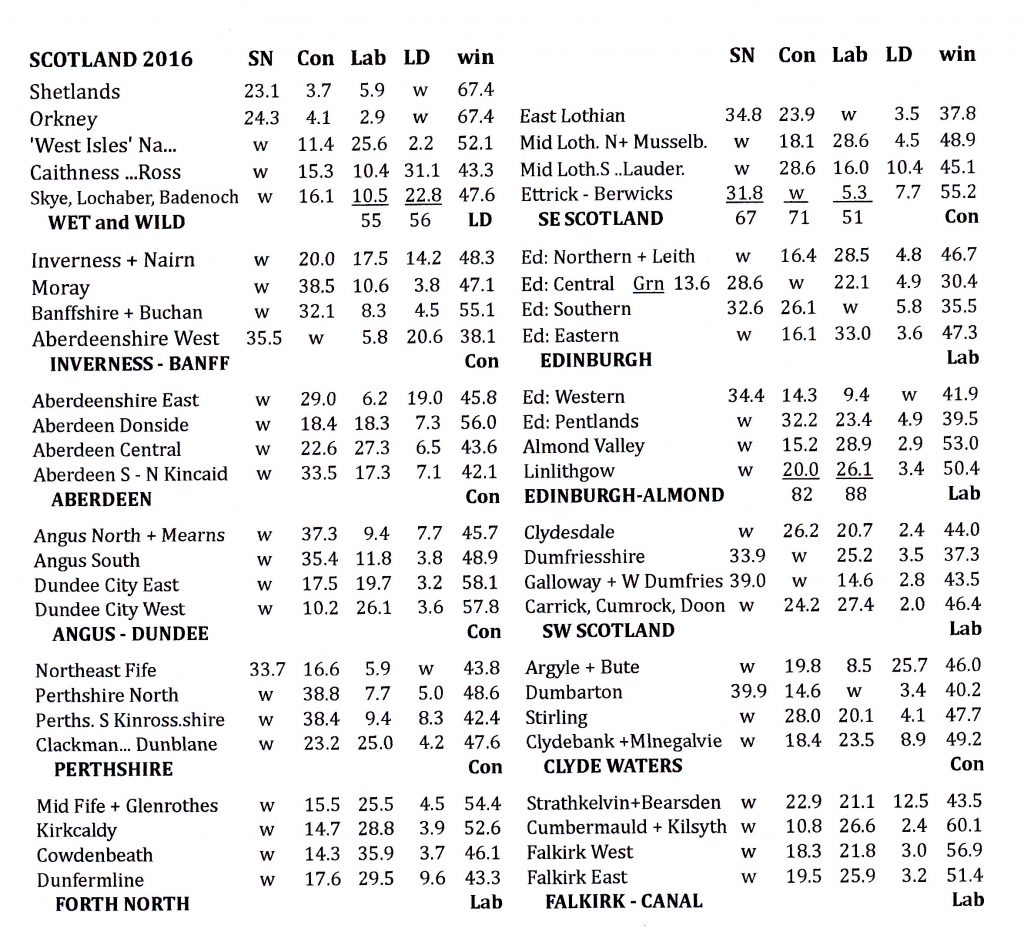
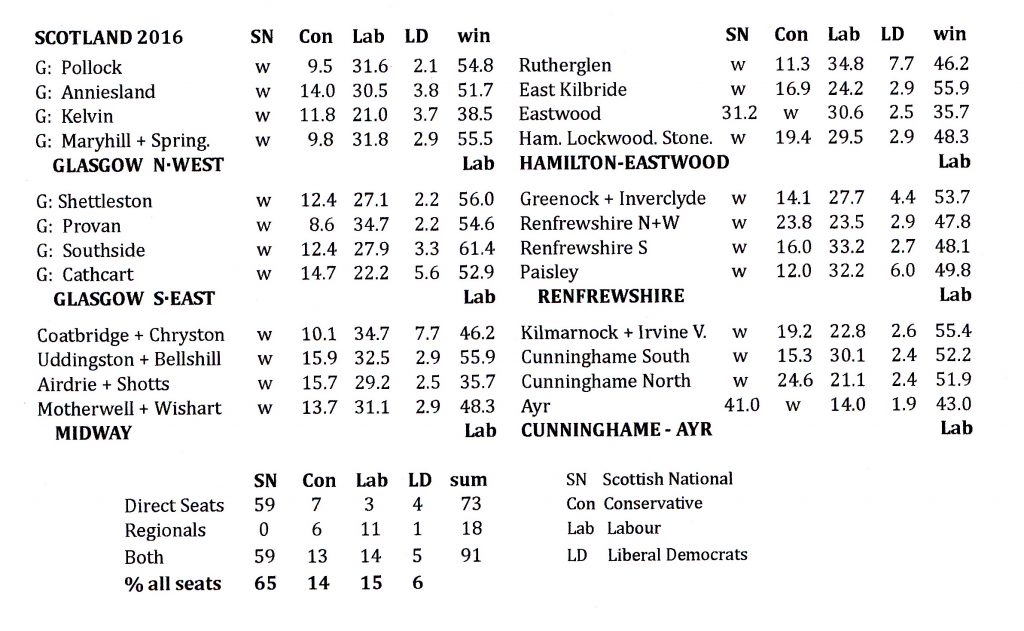
As RS has mostly directly elected Members, it typically gives majority gov’t, as here. But the actual 2016 election with list Members added, saw SNP with only 63 seats in a Parliament of 129___ 48.8% of the seats.
The latest election was not greatly different — again, RS gives a majority gov’t.
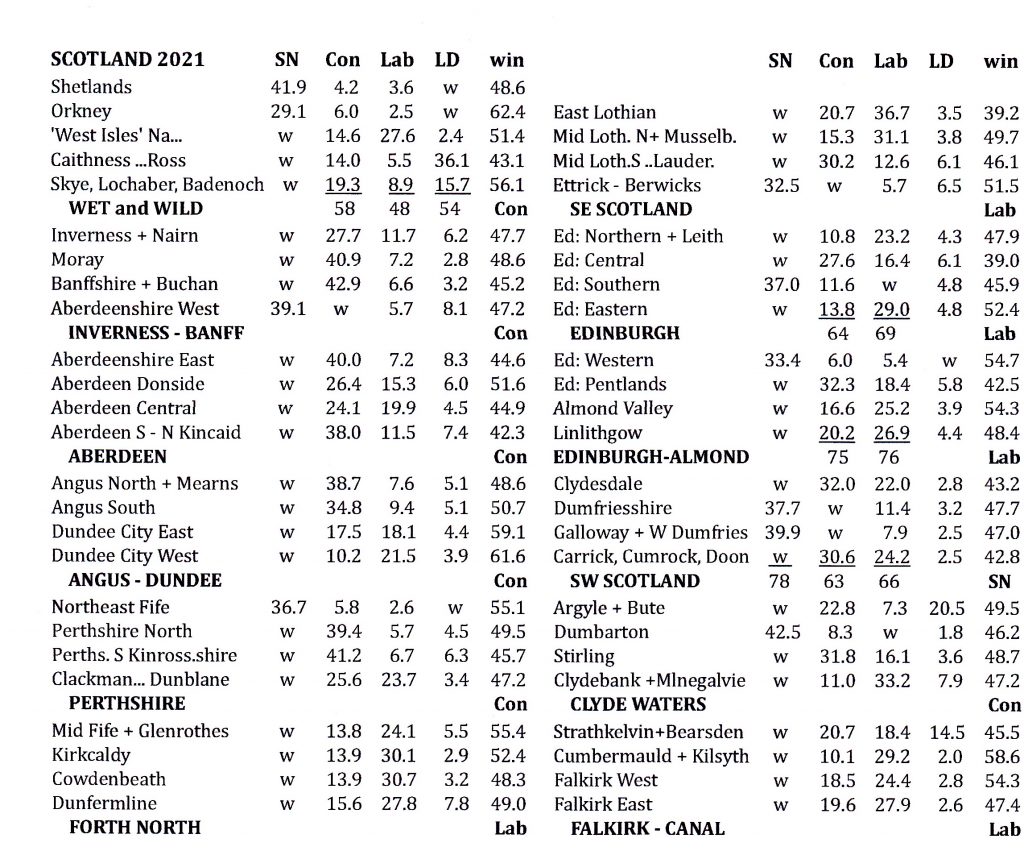
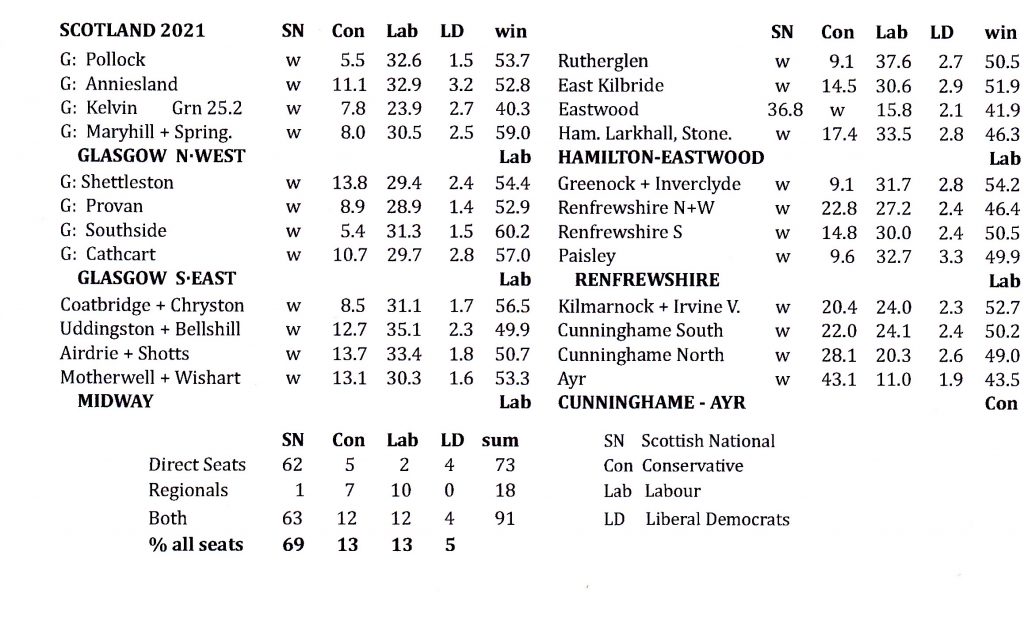
Here are a couple of older elections, where in one case no majority ensued, though this is merely demonstrative of the concept. Obviously, there would be many more electoral districts were an RS system used.
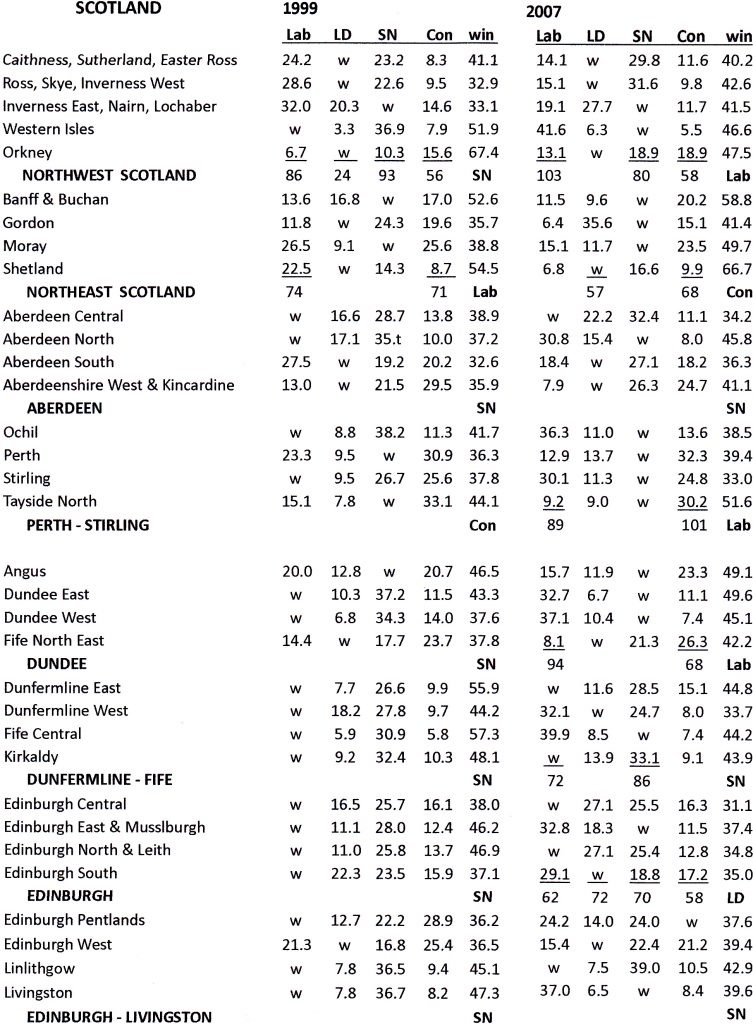
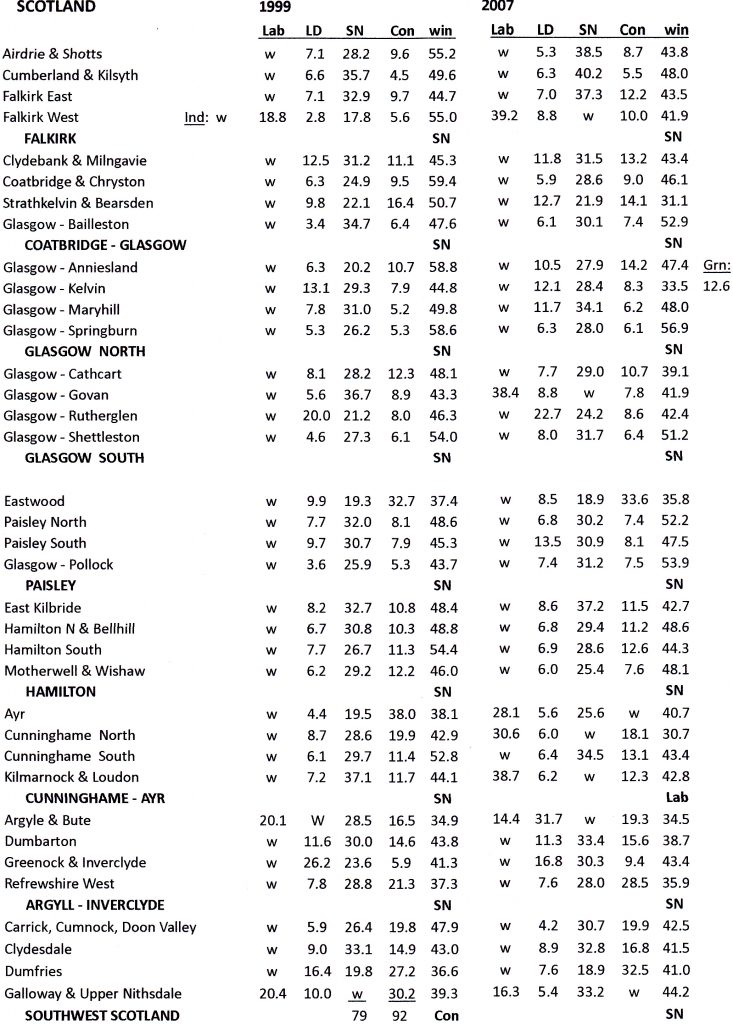
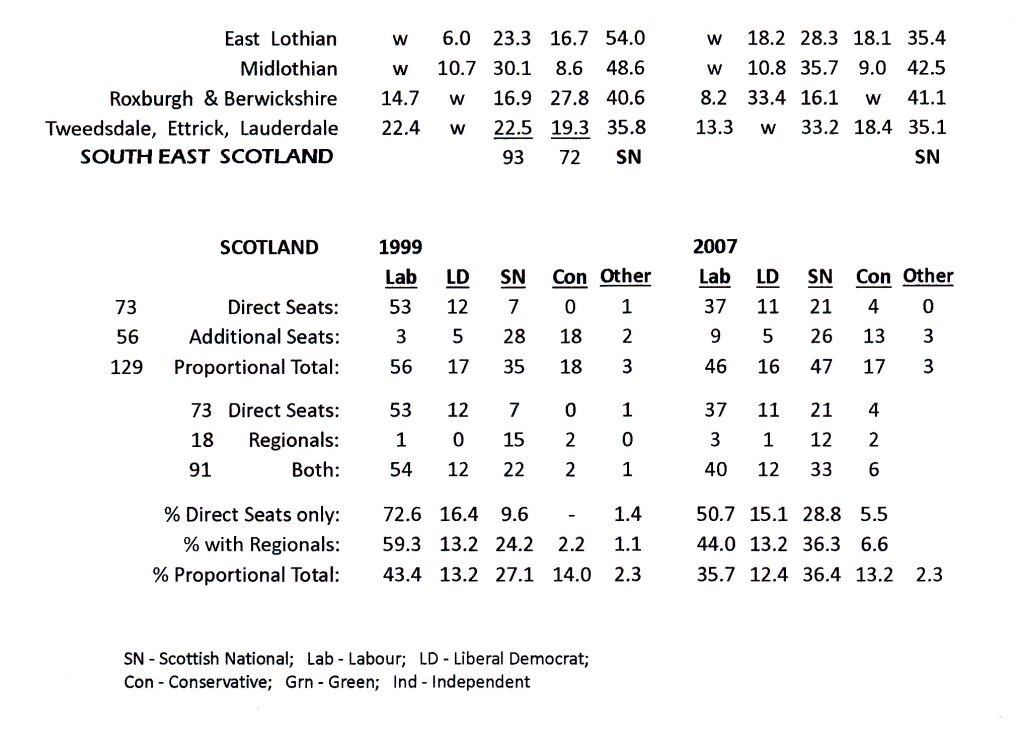
Wales 2016
Were an RS system adopted, likely the Assembly would remain with 60 Members, but now 48 would be directly elected (perhaps using ranked choice ballots) while 12 would be Regional Members.
2016 as if voting had been under an RS system — Of course it was not, but taking the results for those directly elected using first past the post (FPP), and grouping those seats into ten regions …
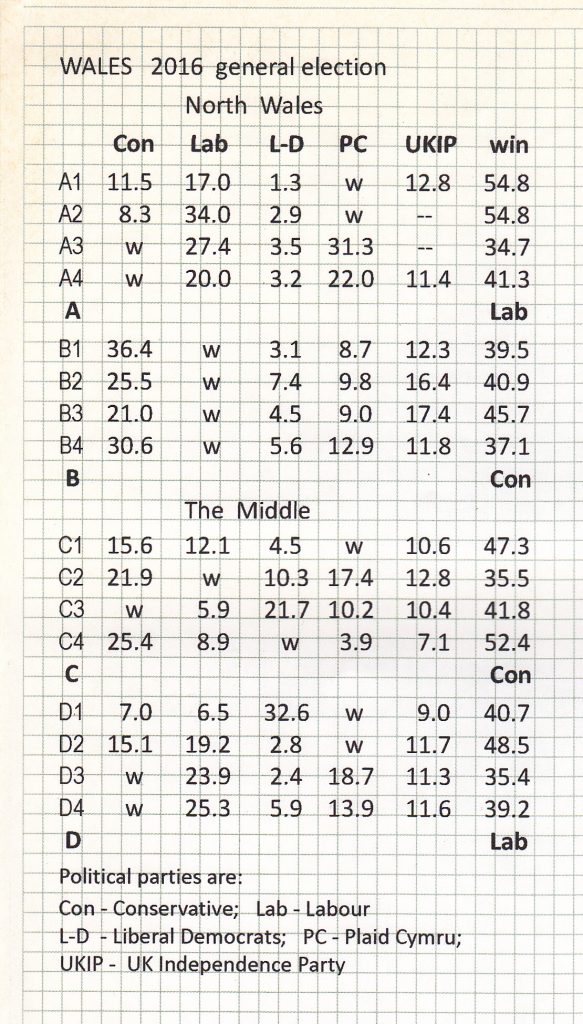
{ See below for the names of these constituencies}
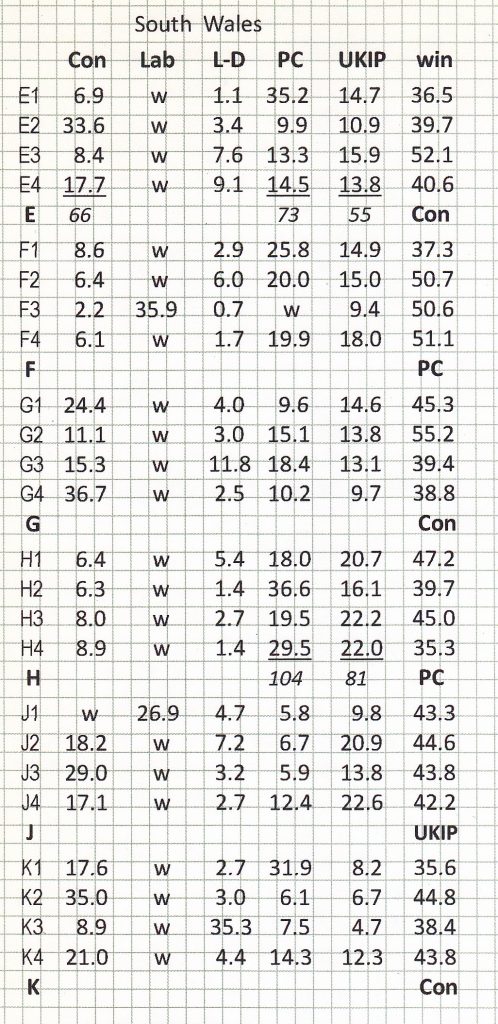
The election was under the Additional Member system, with 40 Members directly elected FPP style and 20 more selected from party lists based on voting for parties. (It is also called Mixed Member Proportional.) Comparing the above results as if Regional Seats voting had been used, with the actual results for those directly elected …
Likely with RS a majority Labour gov’t would have resulted.
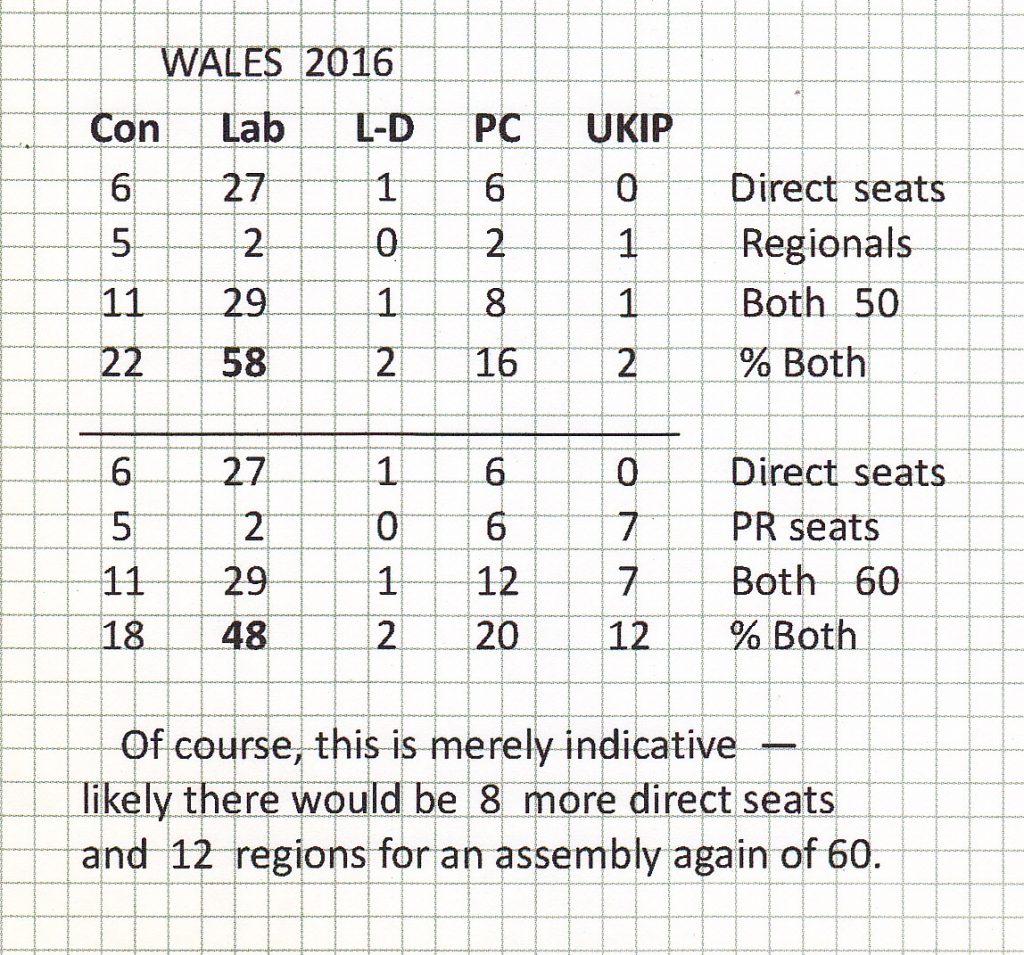
- A_ 1- Ynys Mons; 2- Arfon; 3- Aberconwy; 4- Clwyd West
- B_ 1- Vale of Clwyd; 2- Delyn; 3- Alyn & Deeside; 4- Wrexham
- C_ 1 – Dwyfor Meirionnydd; 2- Clwyd S; 3- Montgomeryshire; 4- Brecon & Radnorshire
- D_ 1- Ceredgion; 2- Carmarthen E & Dinfur; 3- Car..W & Pembrokeshire; 4- Preseli & Pembrokeshire
- E_ 1- Llanelli; 2- Gower; 3- Swansea East; 4- Swansea East
- F_ 1- Neath; 2- Aberavon; 3- Rhondda; 4- Cynon Valley
- G_ 1- Bridgend; 2- Ogmore; 3- Pontypridd; 4- Vale of Glamorgan
- H_ 1- Methyr Tydfil & Rhymney; 2- Blaenan Gwent; 3- Islwyn; 4- Caerphilly
- J_ 1- Monmouth; 2- Newport East; 3- Newport West; 4- Torfaen
- K_ 1 – Cardiff West; 2- Cardiff N; 3- Cardiff Central; 4- Cardiff S & Penarth